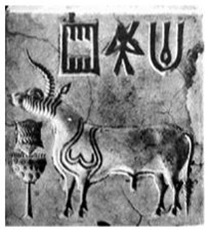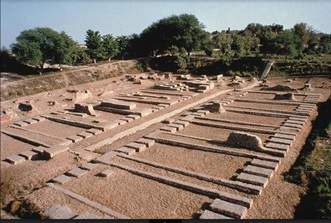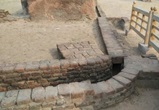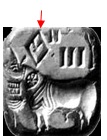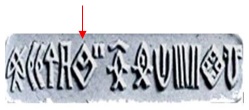The Harappan/Indus seals, as tiny as 3”/3” with a picture of single horned bull and some unique symbols inscribed has remained a mystery because the symbols have remained undeciphered. The seals which were in use around 3500 years back coexisted with Indus civilization and has been correlated with Vedic culture. The central social activity of Vedic period was the performance of Yajna (sacrifices) that are detailed in the Vedas, conducted and performed by the priestly class who were initiated into Vedic studies and practices. Many sites of Harappa and Lothal have structures that correspond to the divisions of yajna shala. The artefacts and figurines of Indus period are also depicted in the seals as symbols.
This write-up will compare the actual site hitherto called “Granary of Harappa” and its depiction in a seal in a symbolic miniature form. The layout and the disposition of the photograph of Harappan site presented in picture 2, can be seen in a miniature form in one of the Harappan/Indus seal presented in picture 1, along with other symbols. The new interpretation of the first symbol on the seal (Picture 1) is that it is a miniature representation of the Harappan site for carrying out a purification or Shuddhi ritual called “Janyabhayapanodana” performed at the excavated platform of Vedic arena, at the beginning of big yajnas. The site also shows the various divisions that were part of the Pasu vedi where animal sacrifice took place as a preliminary to big yajnas.
The first symbol on the seal (Picture. 1) appear to be the miniature plan picture of the hitherto called “Granary of Harappa”, even though the site has not shown any evidence of grains or the storage bins in the area. The site (see picture 2) shows a brick structure built in an area of 45/45 meters with many sub structures within like a path way, rectangular blocks, stepped structures, animal sacrifice shed, and so on. On either side of the pathway are 6 brick structures in rectangular shape with three small divisions on both the eastern and western sides. The central passage has a narrow path laid with bricks which leads to stairs on one end and a small rectangular pit on the other end.
The disposition of the site correlates with Mahavedi, and with sacrificial arena called “Vitritiyadesha”, which leads to the view that this is a place where a ritual of big yajna called “Nirudha Pasubandha” was performed. Pasubandha was the model pattern of the sacrifice of a disemboweled animal, an independent rite, performed every six months, and takes two days, first day of preparation and the second day of immolation. Six priests were engaged.
“Janyabhayapanodana” is a purification rite that was performed on the western side of Vitritiyadesha to drive out the danger or negativity emanating from the priests/men. It is performed at the initial stage by kicking out a ball of earth or dirt with leg outside the Vedi at the beginning of Soma yajna where many priests participate. This is classified under Shuddhi, where after the physical cleaning called Bahya-Shuddhi of body by a bath, the internal cleansing – Abhyantara, is observed that signifies inner cleaning for a total purification of the priest.
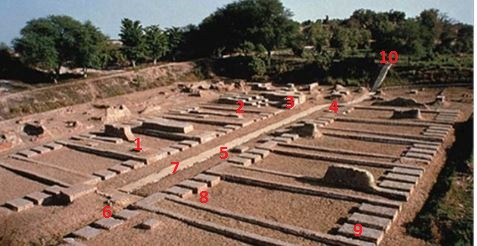
Picture 3. The Mahavedi with the Vitritiyadesha at Harappan site. The other divisions marked,and numbered.
Picture 2 and 3 is the actual site of Harappa, which has all the 10 divisions of the vedi for animal sacrifice mentioned below and are numbered in the image. One can understand how the priests had to purify themselves before taking part in any vedic ritual. Some vedic terminologies that are associated with the rite are numbered in the site picture and furnished with details.
- Agnyagara – a shed where the three sacrificial fires are preserved.
- Shamitra sala– is the sacrificial shed situated to the west of mahavedi where the animal is slaughtered. The picture 4 below is from Lothal site
- Uttaravedi – is the upper or high altar square in shape, erected in the east, situated with in the sacrificial arena. Offerings are made in the hearth of uttaravedi during upasad (preliminary rituals) of soma yajna. The site picture 5 below is from Lothal. Some more seals with the symbol of uttaravedi
- Uvadhyagoha – is the pit dug up in which the faeces, the undigested grass of the disemboweled animal of sacrifice are buried. It is situated to the west of shamitra
- Utkara’– is the little mound made up of earth dug up (that is seen both in the site picture and the seal) situated to the North-eastern portion of the Vedi. The cut-up grass – called ‘Stambha Yajus’ – were dumped in Utkara.
- Chatvala is the square pit (seen above the seal and in the site, picture 1 & 2) measuring one shamya square (36 angulas), dug up outside the vedi near the north-eastern part, from which the loose earth called “purisha” was drawn to make the 3 seats for priests called “dishnyas”.
- Samchara patha – A narrow path assigned to the priests for their movement within the sacrificial arena during the performance of a Yajna, lying between the dishnya seats and extending from Chatvala pit upto utkara
- ‘Vitritiyadesha– is the third part of the excavated plot, the vedi as the ritual platform. The platform is divided into 3 parts by seats for priests called dishnyas both in the eastern and western halves. Utkara is made 2 steps near it.
- Dhisnyas– are small seats, separated from one another by 18 angulas, raised by using the earth of the square chatwala
- Shala dvarya – the entrance door of the arena.
Before the commencement of yajna, the six priests, after the initial physical cleansing of bath had to perform a ritual of internal cleansing for driving away the negative thoughts of the mind so that they become totally purified and are eligible to perform a yajna. A mud ball of earth or dirt was kicked out with leg outside the vedi (Apasthambha sutra 11.7.2).The numbers indicated are according to the details mentioned above and its location in the site picture.
The procedure of yajna was as follows:
- Initially, six priests were hired and Janyabhayapanodana rite was observed in Vitritiyadesha, (*8). The rite Sthamayajur of cutting the grass in the area and putting it in the utkara pit (*5) along with recitation of mantras was performed. A new ahavaniya altar called uttaravedi (*3) was installed. The wooden post called Yupa was installed in front of fire altar uttaravedi to which the sacrificial animal was tied. Dishnya seats (*9) were made with the earth dug out from chatwala pit (*9).
- The principal part of beginning was, logs of wood were fed to the sanctuary of three sacrificial fire place called agnyagara (*1).The priests used “Samchara patha”(*7) in between the rectangular plots. Samchara is assigned to the priests for their movement, within the sacrificial arena during the performance of yajna rituals.
- A sacrificial goat tied to the yupa post was bathed and led to the shamitra shed, (*2) immolated along with the recitation of specific stanzas called “Adhrigu”. The animal was disembowelled and the undigested grass was buried in the Uvadhyagoha pit (*4) near the shamitra The victim’s belly was cut open and omentum (vapa) was offered to Agni and Indra in the uttaravedi.
- The limbs were cooked in a big vessel called srapana (Third symbol on the seal) and ghee was poured and different limbs were offered to different deities.
The symbols inscribed in the Harappan seal shown in picture 1 are
- The three divisions of the dishnyas are inscribed as the first symbol. Above the rectangular frame on top are seen the square chatvala pit and the circular utkara mound, which have been identified in the picture 2 of the site.
- The second symbol in the seal indicates the presence of the Yajurvedic priest ‘Adhvaryu’ with the sword shaped wooden implement called sphya on his shoulder (to ensure the safety and unhindered performance of the yajna) made of khadira wood and one pradesha in length (12 angulas). It was the duty of this priest to perform manual jobs of cutting the grass with sphya, measure and draw the outline of the vedi, make the utkara
- ‘Srapana’ a big vessel with the ladle to cook the milk or food in the large vessel is indicated as the third symbol inscribed in the seal. The symbol of the seal, Vitritiyadesha, can be compared to actual excavated plot at the Indus site. Janyabhayapanodana rite after clearing the arena of Vitritiyadesha, by symbolically kicking out a ball of earth or dirt with leg outside the vedi at the beginning of yajna. This rite confirms the purification of negativity emanating by men both externally and internally and makes them eligible to participate in yajna rituals. The adhvaryu priest and his three assistants used the samchara patha for their movement.
Conclusion
The above mentioned Harappan site is actually a Vedic arena for rituals involving altars, fire sanctuary, vitritiyadesha, and shamitra shala for conducting Nirudha pasubandha ( model form) animal sacrifice, where the immolation of a goat took place as a preliminary of big yajnas. All priests had to undergo a purification rite before the commencement of Yajna in Vitritiyadesha. The details of it are documented in the Harappan seal as a symbol in miniature form.
Reference:
- “Symbolography In Indus Seals” by Rekha Rao
- A Dictionary of the Vedic Rituals by Chitrabhanu Sen.
Featured Image: Harappa.com/ Picture credits: Harappa.com, Pictures of Lothal are from Akhilesh Magal
Disclaimer: The opinions expressed within this article are the personal opinions of the author. IndiaFacts does not assume any responsibility or liability for the accuracy, completeness, suitability, or validity of any information in this article.
Independent Researcher and Indologist, Mysore


